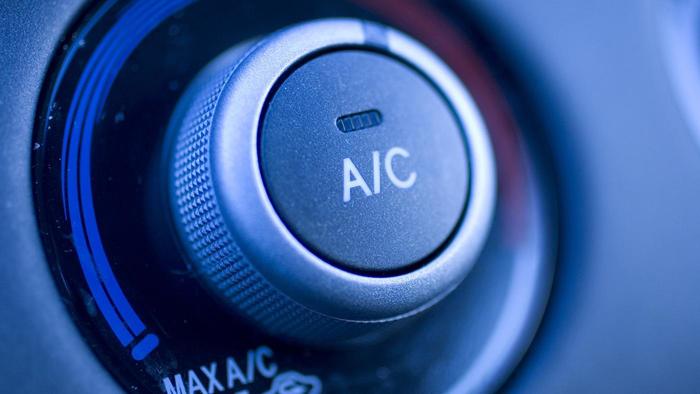Car air conditioning is the single most important system dedicated not to the operation of the vehicle, but to the comfort of the individuals inside. Basically every other system—engine, fuel, electrical, cooling, exhaust, drive train, braking, suspension and ignition—contributes to the functioning of the vehicle itself. A car or truck without one of these systems wouldn’t work.
The air conditioning system of a car, on the other hand, could be removed without any loss of function. Indeed, an A/C compressor draws power from the engine, slightly reducing the efficiency of the vehicle. The functionality of the driver and passengers, however, is dramatically enhanced by air conditioning’s cooling effect, which is why it’s important to know how to fix an A/C leak.
Car Air Conditioning Components
Air conditioning was a later addition to cars and trucks. Vehicles were not widely equipped with it until about 70 years after internal combustion vehicles were introduced. Ask the drivers and passengers about the A/C and they are likely to consider it indispensable. It is difficult to purchase a new car or truck today without it.
Like most automobile systems, the air conditioning system is a complex series of motors, belts, hoses and fluid generating pressure and heat to serve its function in the automobile. Unlike other systems, its function is to remove heat and humidity from the passenger compartment and blow cooler air into it.
These are the main components of a car or truck air conditioning system:
Refrigerant: The substance that flows through an air conditioning system to absorb and release heat is called refrigerant. Until 1995, this was the inert gas freon, sometimes known as R12 refrigerant. Upon discovering freon emissions were contributing to the destruction of the Earth’s ozone layer, which protects its inhabitants from the sun’s most harmful UV rays, the federal government banned use of R12 refrigerant in new cars. Today most vehicles use its replacement, R134a refrigerant.
Refrigerant must have certain qualities to work in an air conditioning system. It must absorb and release heat easily and have a very low freezing point. In other words, it cannot turn into a solid, like water does, at temperatures near 32 degrees Fahrenheit. This is because the refrigerant will be subject to extreme cold and must be able to flow through the system.
Compressor: The compressor is the only mechanical component in the air conditioning system. The compressor is powered by the mechanical motion of the crankshaft to put refrigerant under immense pressure, raising its temperature in the process. The compressor then pumps the refrigerant gas through hoses and into the condenser.
Condenser: The car A/C condenser receives refrigerant gas under high pressure from the compressor and exposes it to significantly lower outside temperatures, much the same way a radiator exposes engine coolant to atmospheric temperature. The refrigerant passes through the folded coils of the condenser and it relinquishes its heat to the air and cools to a liquid. The condenser is usually located under the hood in front of the radiator, giving the appearance of a second radiator in the car.
Receiver-Dryer: After leaving the condenser, the liquid refrigerant flows to the receiver-dryer, whose purpose is to remove any moisture that might have infiltrated the system. Water is fatal to an air conditioning system because it freezes. Moisture-eating granules in the dryer, called desiccants, purify the refrigerant and keep it flowing through the system.
A/C hoses: The hoses through which the refrigerant flows are like veins in the human body, carrying crucial liquid and gas from one component to another. They are also the source of the most common problem facing the air conditioning system—leaks.
Evaporator: After passing through the purification process in the dryer, the hoses carry cold liquid refrigerant to the evaporator, the workhorse of the air conditioning system. The evaporator looks like the condenser’s cousin, with coils of its own, but its purpose is the exact opposite: to absorb heat and humidity from the passenger compartment and blow cold air through the vents onto the driver and passengers. As the refrigerant warms up with the compartment’s heat, it turns back into gas as it flows back to the compressor to complete its journey and begin the process all over again.
Indicators of an A/C Leak
A refrigerant leak in a car A/C system is cause for concern. Leaking fluid reduces the air conditioner’s ability to cool and puts a strain on the compressor. Eventually, if enough refrigerant leaks out, the A/C will stop working.
Refrigerant is colorless and not very pungent. It might look like water dripping on a driveway. It is difficult to diagnose as an air conditioning leak. Therefore, other methods must be used to detect a leak.
- A clicking sound. The indication that you’re in need of car A/C repair is when you hear the compressor making a clicking sound. With less gas to compress, the compressor begins short cycling, much like we would gasp for air if we were at high altitude. This makes a clicking sound that serves as the earliest warning system of a leak in the A/C system. There are several causes of short cycling, but low refrigerant is the most common. Again, this is an early warning sign and immediate attention is required.
- An early warning dashboard indicator. Once the refrigerant level reaches a critical state, an early warning light may appear on the dashboard. That is an indication that the system may be leaking and you need to fix the A/C leak in the car. Failure to do so leads to indicator number three.
- The A/C stops cooling. By the time the A/C is blowing hot air, it is too late to take preventative measures. There are many possible causes of a malfunctioning car air conditioning system, but the most common is that most of the refrigerant has leaked out. At this point, you should only consider car air conditioning repair if you want cool air in the vehicle.
How to Fix a Car Air Conditioning Leak
In order to seal a leak, the refrigerant must first be removed from the A/C system, a process called evacuation. Following repair of the leak, the refrigerant must then be replaced, or recharged. The cost for this at a service station ranges from $250-$400.
If taking the car in for repair isn’t an option, another alternative is to repair leak points in the condenser, evaporator, connection hoses, gaskets and o-rings with Red Angel A/C Refrigerant Stop Leak. A bottle costs around $37.95 and it contains 4.5 ounces of R-134a refrigerant plus stop leak. Red Angel A/C Refrigerant Stop Leak is specially formulated to repair leak points without solid or particulate matter that can clog the system.
To use Red Angel A/C Refrigerant Stop Leak, locate the A/C low side service port, usually located between the evaporator and compressor. It may also be found on the larger-diameter A/C line. It looks like a port that can accept the coupler attached the product container.
Start the engine and turn the air conditioning all the way up. Shake the can well and connect it to the low side service port. Depress the top of the can to dispense the product for 3-5 minutes until the can is empty.
The contents of Red Angel A/C Refrigerant Stop Leak are toxic, so avoid inhalation or contact with skin. This product only works on R134a refrigerant and it is not designed to stop the loss of more than a pound daily, as that suggests a larger leak.
Red Angel A/C Refrigerant Stop Leak is not designed for compressor leaks. The compressor must be replaced if it leaks, at a wide range of costs. For a common vehicle like a Honda Civic or Toyota Corolla, an after-market compressor costs about $200, with another $200-$300 for labor at a mechanic’s shop. A dealership often charges more for labor, and these costs escalate if the vehicle is larger or less common. In either case, the refrigerant must be emptied from the system and replaced the repair. That generally adds another $150 or so.
Although the air conditioning system conveys comfort, not function, in an automobile, its reliable operation is important to most people. The best way to maintain the proper functioning of the A/C is to pay attention to warning signs that something may be amiss and repair it before the system ceases to work.
BlueDevil Products can be found at AutoZone, Advance Auto Parts, O’Reilly Auto Parts, NAPA, Parts Authority, Auto Value, Bumper to Bumper and other major auto parts retailers.
BlueDevil Products can be found on Amazon.com or at AutoZone, Advance Auto Parts, O’Reilly Auto Parts, NAPA, and other major auto parts retailers.
3 responses to "How to Fix a Car Air Conditioning Leak"
3 Comments
Leave a Reply
Related Articles




Very good info!!
Although this is most likely just a commercial for a stop leak product. The information contained herein is invaluable and concise an all in one easy to understand explanation. I easily found the problem and fixed my AC myself without paying for costly repairs. I wish I would have found this long ago thanks
I was quite surprised that during the video you did not show the actual processes. There were great pictures of the mechanics, their clipboards and some of customers but no portion of the video were related to the actual repair process. It was a nice over view but I would have to say the title is extremely misleading.